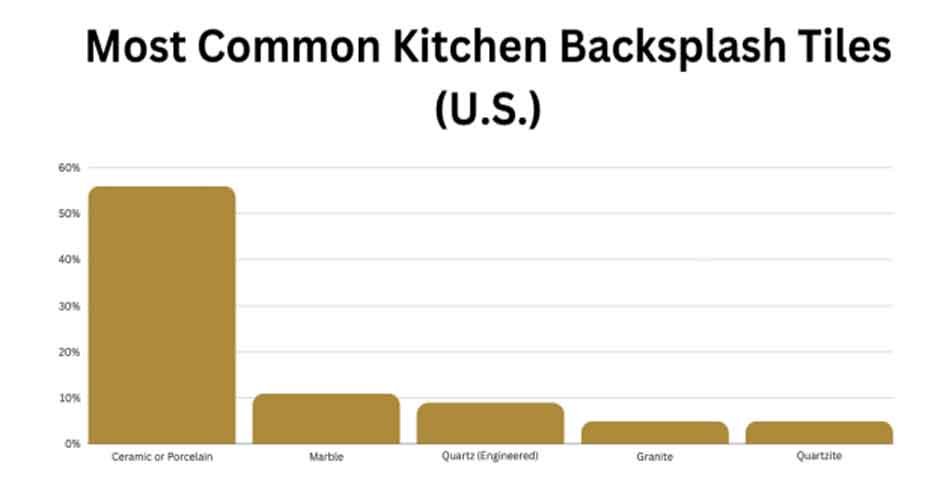
The backsplash is one of the most visible parts of any kitchen. Selecting the right backsplash tile can elevate your kitchen’s design while simplifying cooking and cleaning. This ultimate guide will walk you through the process of selecting the perfect backsplash tile for your needs.
The backsplash serves both form and function in a kitchen. Visually, it brings together the countertops, cabinets, and other elements. Practically, it protects the walls from splashes and stains. With so many backsplash tile options now available, it’s important to make an informed decision. The right backsplash tile can enhance your kitchen’s aesthetics while also standing up to heavy use. This guide will equip you with the knowledge to choose the ideal backsplash tile to match your kitchen’s style and your lifestyle.
Types of Backsplash Tiles
Now that you understand the importance of choosing the right backsplash tile, let’s dive into the various options available. Each kind of kitchen backsplash tiles has its own unique characteristics and advantages.
Ceramic Tiles
Ceramic tiles account for approximately 80% of all tile purchases in the United States. They are known for their durability, making them a popular choice for kitchens. These tiles typically have a lifespan of 20-30 years with proper maintenance. Their glazed surface resists moisture, stains, and odors. Ceramic tiles now come in a wide array of colors, textures, shapes, and patterns. They offer an affordable option that combines quality with design flexibility.

Glass Tiles
Glass tiles can reflect up to 98% of light, making kitchens appear brighter. Their sleek, modern look has fueled a 5% year-over-year growth in popularity. Glass backsplash tiles are available in an array of colors, finishes, and degrees of opacity. Combining various glass tiles enables you to create a truly unique backsplash. Just keep in mind that completely transparent glass tiles show any wall imperfections. Frosted and opaque glass tiles conceal flaws while still bouncing light around the kitchen.
Natural Stone Tiles
Natural stone tiles convey an unparalleled elegance, with each piece featuring distinctive veins, swirls, and patterns. Granite and marble are two popular options, with granite comprising 40% of kitchen installations. Beyond their beauty, natural stone tiles boast longevity, with some varieties lasting over 100 years. However, they are porous and require yearly sealing to prevent staining. Regular cleaning is also a must to keep them looking like new. While expensive, natural stone backsplashes provide timeless sophistication.
Subway Tiles
Subway tiles are a classic choice, first used in New York City subways in the early 20th century. Their simple brick pattern has stood the test of time and remains widely popular. In fact, the brick layout is the most common subway tile design, favored by 45% of homeowners. Available in glossy white or earthy hues, subway tiles offer a clean, understated look. Their rectangular shape allows for countless creative layouts. Durable and easy to clean, subway tiles bring vintage charm to both modern and traditional kitchens.
Considerations for Choosing the Right Backsplash Tile
As you explore the different types of backsplash tiles, it’s essential to consider various factors that will help you make an informed decision tailored to your kitchen’s style and your preferences.
Kitchen Style and Design
According to a survey by the National Association of Home Builders, 72% of homeowners prioritize a cohesive kitchen design. This means that not only should your backsplash tiles be functional, but they should also complement the overall style of your kitchen. For traditional kitchens, classic subway tiles or textured stone backsplashes work well. Modern kitchens shine with sleek glass or ceramic tiles in cool hues. Cottage-style kitchens look best with a mix of handmade tiles in cheerful colors and patterns. Ensure your backsplash aligns with your kitchen’s look and feel.
Color Palette
The color of your backsplash tiles impacts the ambiance of the kitchen. While 85% of homeowners prefer neutral or white backsplash tiles for a timeless look, bold and colorful backsplashes have been trending, with a 9% increase in vibrant tile usage. Warm earth tones promote a cozy feel, while cool grays and blues create a relaxing vibe. Remember that natural light affects color perception. View tile samples at different times of day before finalizing your selection.
Budget Constraints
On average, homeowners spend between $10 and $40 per square foot on backsplash tile materials and installation. Ceramic or porcelain tiles can save up to 50% compared to premium materials like natural stone and glass. Mosaics made up of small tiles also cost more in terms of labor and grout. Simple subway tile layouts provide an economical option. Talk to tile showrooms about sales and bundled packages to maximize value. With some savvy shopping, you can find beautiful backsplash tiles to match your budget.
Tile Shapes and Patterns
The shape and pattern of your backsplash tiles impact the overall look just as much as the type of material. Explore your options to find the right visual appeal for your kitchen.
Standard Tile Shapes
Square and rectangular tiles are classic choices, with square tiles being the most popular at 40% of installations. Their clean lines lend them to uniform layouts. Rectangular subway tiles allow for brick patterns. Hexagonal tiles have also gained popularity, with a 16% increase in installations. Their unique shape enables creative arrangements. Octagonal, fish scale, and diamond tiles provide even more shape variety.
Creative Patterns
Herringbone and chevron patterns add visual intrigue, favored by 24% of homeowners. These angled designs make small spaces appear larger while adding a touch of elegance. Mosaic patterns are also captivating, with Tile Trends Magazine reporting a 12% gain in popularity over the last two years. Mixing mosaic, diamond, hexagon, and square tiles lets you craft a one-of-a-kind backsplash.
Maintenance and Cleaning
While aesthetics play a crucial role, the practicality of your backsplash cannot be ignored. Let’s delve into the essential aspects of maintenance and cleaning to ensure your chosen tiles remain beautiful. According to the National Kitchen & Bath Association, 68% of homeowners prioritize easy-to-clean materials for their kitchen backsplash. Sealed natural stone tiles are stain-resistant and simple to maintain with regular cleaning. Glossy glass and ceramic tiles repel grime and moisture. Consider your lifestyle and cooking habits as you choose tiles that will withstand busy kitchen activity.
Installation Tips
Before making your final tile decision, you need to consider how they will be installed. DIY installation can save up to 50% of labor costs but requires the right tools and skills. If tiling is new to you, practice first on a non-critical area. Professional tile installation ensures precision and typically includes a warranty, providing peace of mind. Whichever route you choose, use tile spacers to maintain even grout lines. Allow tiles to set for 24 hours before grouting. Thoroughly clean grout haze once dry. With care and patience, you can achieve a stunning, professional-looking backsplash.
Frequently Asked Questions
Now that we’ve covered the key aspects of choosing the right backsplash tile, let’s address some common questions homeowners have when embarking on this journey:
What is the most durable backsplash tile material for a high-traffic kitchen?
Ceramic tiles stand up extremely well to heavy use, making them a top choice. Their durability and longevity also make them ideal for busy kitchens.
How do I choose the right grout color for my backsplash?
Matching grout seamlessly blends with your tiles. Contrasting grout makes the tiles pop. White and light gray grouts are popular choices that enhance any color tiles. Ultimately, consider the desired look.
Are there eco-friendly options for kitchen backsplash tiles?
Yes! Recycled glass tiles prevent waste while glass and ceramic tiles made with recycled materials provide sustainable options. Reclaimed quarry tiles also offer green benefits. Discuss eco-friendly backsplashes with retailers.
Final Takeaway
Choosing the perfect backsplash tile involves considering your kitchen’s style, color schemes, patterns, practicality, and budget. Settling on the right backsplash is an exciting process that can refine your whole kitchen’s look. Use this guide to make an informed decision that suits your needs. With a striking yet functional backsplash that fits your lifestyle, you’ll enjoy your beautiful kitchen for years to come.

